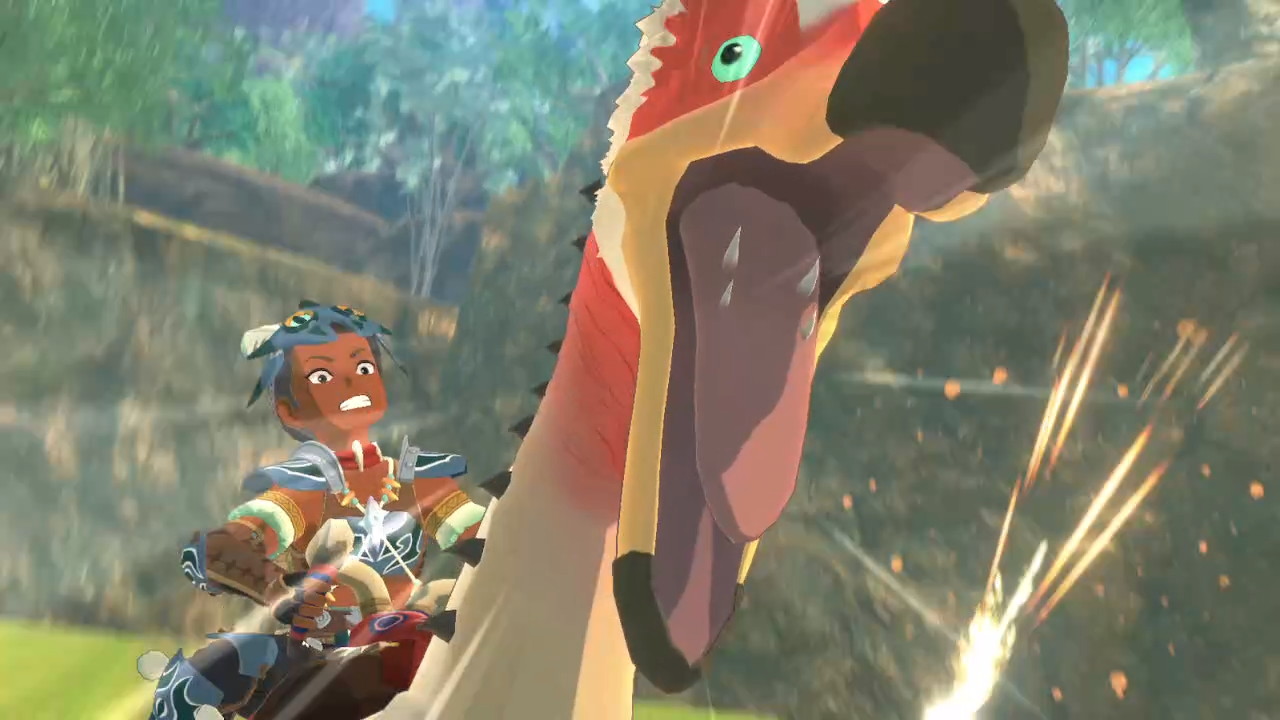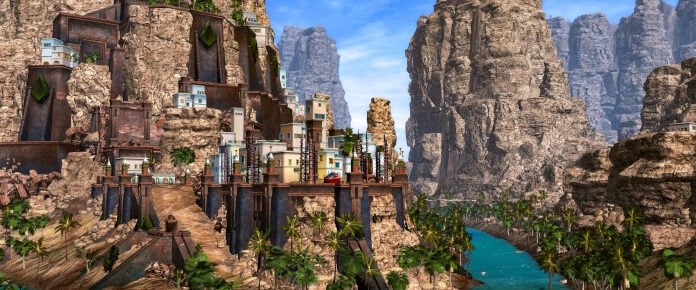
So Monster Hunter Stories 2 is out in the wild now, and to be honest, the demo does the game no justice for MH fans, and worse, it hides essentially everything for multiplayer fans, which I’d argue have been the core of the series fans at the start. That being said, I stand by my feelings that this is a good entry point for people who don’t normally do action games but like the character designs or idea of the world.
And that’s why I’m here to talk to you about not just multiplayer in MHS2 but how to get there ASAP. To note, there will be some very minor spoilers (monsters that have been revealed in many trailers or the demo’s gameplay), but we’ll do our best to hide plot-based spoilers for the purists.
Where my hunters at?
In the second quest area, after nargacuga, you get a quick challenge that’ll unlock multiplayer battles – not just the co-op missions that have been pushed more and more lately, which do not require the Expedition Ticket for non-event missions, but also PvP, which actually feels really fun despite this being a turn-based game.
To note, though, co-op missions are not the main story mode, and they take place in another area. You’ll still need to play the single-player bits of the game in order to get more multiplayer content, but so far, it feels worth it. For people looking to B-Line it to multiplayer, click to open a few spoilerish tips.
• Stick to the main storyline. The side quests can be done later, and the game is designed for you to go back later anyway. Plus, again, that’s the easiest way to unlock more multiplayer content even after you gain access to it.
• Finally, use bottle caps to keep your stable max high, grab any Royal Ludroth (green and yellow striped egg) for swimming, and if your stable gets full, invest in the first four
Obviously don’t worry too much about rare genes at this point, as you’ll be able to upgrade entire monstie families later, and egg hunting is basically what the game is all about. To note, though, you may hear about people changing the color of their monsters. So far, not only is that a bit tricky, but it seems like it’s unstable even in endgame. That being said, we received a Nintendo Switch review copy of the game at the last minute (the game is also on PC), so I’ve yet to experience that endgame for myself.
Co-op missions are picked up at the quest board usually located near the town entrance, much as in core Monster Hunter entries. Before going on a co-op mission, you’re placed in a “Riders Hub,” where you can gather items similar to when you’re in the overworld. There are no monsters, just mushrooms, honey, herbs, and even charms. When you’re ready, you can just select the “Start Now” option in your menu to leave on the mission. That means you don’t need a full group to start any of the missions, as AI will fill in (and do the same in case anyone is booted/disconnected from the group).
I’ve seen only two-player Co-op missions so far, and sadly they make support-type players feel like a bit of a drag, as you are trading moderate buffs for nearly half the damage for the most part.
During co-op missions, you won’t be able to use the Quick Finish mechanic no matter how over-leveled you may be. There may be some lag when trying to join after someone else is started a battle, possibly because you have about a minute to decide on your actions before they’re executed. Remember, people can choose to join you in battle, or you can split up. I’d argue that most people tend to dodge all the monsters except for the final boss, so unless you’re playing with a friend, you may want to expect this kind of playstyle, as it’s been exclusive to every single co-op mission I’ve done.
This is important to note because once you’ve finished the main objective, you have one minute to wrap everything up: eggs, gathering, battle, etc. I’m not sure how the game will address stragglers, so unless you want to risk missing out on your reward eggs, you may want to try to keep up. Don’t worry too much about this; many players do seem to make pit stops for chests, and some bring “Roar” monsters (which essentially root mobs in place for a few seconds) to help the party dodge trash.
Building on simplicity
One key note here is that the rock-paper-scissor methods plus type weaknesses can be a bit hard to memorize. While damage type weakness for basic weapons (not elements) is present on screen, elemental types are not. When there are only two people, it becomes very obvious very quickly not only who knows the type weaknesses but who is paying attention to the on-screen notification. In this way, MHS2 still allows vets to shine but feels as though it also puts a strong spotlight on weak hunters.
While this can be a learning tool, it can also be frustrating when your partner simply button mashes, perhaps while watching a movie or something. As communication via stickers is limited, much as in Monster Hunter Rise, playing with randoms can feel like trying to give buggy AI commands that it may refuse to follow. While the levels are fairly simple, playing out like a more complex version of Pokemon Sword and Shield’s dungeon-esque Dynamax Adventures, the levels still retain one boss monster thus far. This means that players tend to skip a lot of the “content” and rush to collect treasure chests while dodging trash mobs.
This is why it feels as if instanced copies of the world map could have been a much more interesting play. The base game’s random dens, especially Rare Dens, are where MHS2 really shines in terms of PvE, especially for monster collecting fans. The co-op eggs can be just about anything, and not necessarily rare in terms of genes. The species feel quite mixed too, so while it can be nice for targeting rare monsters for parts and possibly increased chances for eggs (at least against boss monsters), the low stats and common monster-eggs are kind of a bummer, especially early on when you can feel that there’s something bigger and better just over the virtual horizon that is the single-player campaign.
Conversely, the game’s Pokemon-esque versus modes (which come in 1v1 and 2v2 versions) award Bottle Caps, a rare currency, which makes them feel worthy of your time so far. Bottle Caps can be used to raise stats and unlock slots on monsties, along with acquiring rare items. While participating gets you two bottles caps, period, winning awards an additional cap for three bottle caps total.
PvP comes with a “balanced” mode (in addition to a quick mode) so that the playing field is a bit more leveled. Even in the balanced mode, player skill, loadout, and monstie choice matter, but the anything-goes type mode so far has felt fair too in that I won a couple of 2v2 matches against a level 28 with some scary-looking monsties at level 20, probably because I was wearing upgraded gear and invested heavily in easy-to-access-and-upgrade monsties.
Once again, seeing who knows the types and who doesn’t becomes quite obvious, as the turn-based nature slows down the usual MH action and puts all player actions on full display. Monster parts will show an X through weapon types, and it’s not uncommon to see a player continually ignore that. You can see how close you are to breaking a monster part, and some guy will continually be whacking away at another part when it’s fairly evident there’s not enough HP left on the monster to break two different parts. While the game communicates MH‘s usually esoteric knowledge in a beautifully accessible manner, there are still players who mindless tap one button and wait for combat to end.
As there’s no team communication options, you’ll need to try to read your partner’s intentions. Choices she makes will be shown to you, albeit briefly, so players need to pay attention. You can also change your battle choices as long as one of you haven’t finalized your character’s attack or until your opponents have finalized their own. Of course, players who aren’t paying attention will make critical errors, like blowing heals on a target you’ve already selected to heal up to full (which the UI clearly displays).
Because PvP battles aren’t simply to the roster-death but instead end when any one player loses three hearts, and because you can attack the monstie or player (similar to the defunct Moonrise game), there’s a lot of strategy going on. Again, using my example of the level 28 player, while he had the level and big monsties, both were often the softer target than their level 16 partners. Layered armor is turned off for battles, allowing you to see what players are really using, which is useful because levels and weaknesses are hidden during combat. When you see starter gear on a player, you can feel how little levels matter.
This means that the early match can be about exploring and hiding weaknesses, while the later game is about figuring out which target is the best to aim for. As your items are limited to pre-set loadouts the game lets you choose from, support players here stand out more. A player who simply heals and buffs can help a partner outlast the fight, a strategy that doesn’t feel very rewarding in the PvE side of the game when players are approaching content that’s level appropriate.
Battles can get a little long, especially in PvP, so even though the mobile online play felt as serviceable as TV play on the Switch, I didn’t feel like I could engage in online multiplayer when I was trying the game out as a mobile title. The single-player content – and there’s a lot of it – felt better for that, and frankly, that’s the biggest issue when trying to look at this game as a multiplayer title.
While Monster Hunter Stories 2 serves as a fantastic entry point into the world of the series and has a lot of cross-over game knowledge that should satisfy fans and newcomers who move into the main series, the multiplayer aspect is very much second fiddle to the single-player aspect, which is inverse of the main series. Pokemon Sword and Shield certainly did the monster-collecting game better in terms of feeling like you can progress via multiplayer (to a point that could be easily improved on), but MHS2 asks you to progress in single-player before jumping into multiplayer. The single-player mode doesn’t feel like a chore at all, but online-gaming purists might become frustrated when having to play catch-up to engage with their single-player loving friends who blast through the main game.
 Massively OP’s Andrew Ross is an admitted Pokemon geek and expert ARG-watcher. Nobody knows Niantic and Nintendo like he does! His Massively on the Go column covers Pokemon Go as well as other mobile MMOs and augmented reality titles!
Massively OP’s Andrew Ross is an admitted Pokemon geek and expert ARG-watcher. Nobody knows Niantic and Nintendo like he does! His Massively on the Go column covers Pokemon Go as well as other mobile MMOs and augmented reality titles!

















